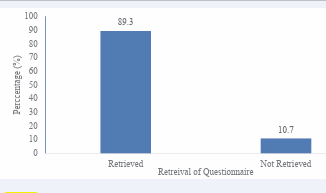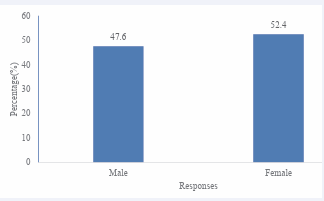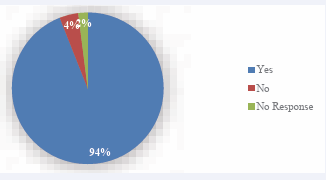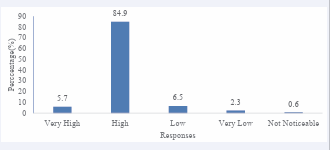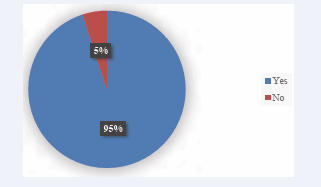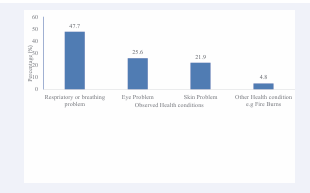Particulate Matter Pollution and Health Status of Residents in Bayelsa State, Nigeria: An Assessment
- 1. Department of Community Medicine, Niger Delta University, Nigeria
- 2. Department of Microbiology, Bayelsa Medical University, Nigeria
Abstract
Objective: This study was conducted to assess the impact of particulate matter pollution on the health status of residents in Bayelsa State in order to proffer recommendations.
Methods: The study adopted a mixed research strategy involving both qualitative and quantitative methods of data collection. The study utilized a cross sectional research design using a field survey of two communities, namely Agbura and Otuasega. The sampling method was a multi-stage sampling technique used in sampling 393 respondents for the quantitative data collection by questionnaire. Eight key informants chosen by purposive sampling were interviewed. A focus group discussion was also conducted with 10 participants.
Results: Among the study’s key findings are that particulate matter pollution is high in Bayelsa State, and the citizens are aware of its occurrence but have poor knowledge of what it is. Respiratory, eye, and skin problems are direct effects, while increased hospitalizations, loss of man-hours, and increased out-of pocket expenditures are indirect effects. Laws, regulatory institutional frameworks, and policies to tackle the problem are scare tactics leading to widespread illegal refinery activities. Furthermore, equipment and regulatory standards for the routine measurement of particulate matter are scant. Enlightenment of the affected communities’ citizens regarding the particulate matter is rare.
Conclusion and Recommendations: Poverty and a high unemployment rate are the major problems that led residents of the area to engage in illegal artisanal refinery activities. Hence, there is a need to set up an all-inclusive institutional framework on particulate matter pollution, intensify regular measurement and information dissemination activities, and engage in public-private partnerships to establish modular refineries.
Keywords
• Disease conditions
• Environmental pollutant
• Human health
• Particulate matter
• Policy on pollution control
CITATION
Sawyer WE, Izah SC (2023) Particulate Matter Pollution and Health Status of Residents in Bayelsa State, Nigeria: An Assessment. Ann Com munity Med Pract 8(1): 1052.
ABBREVIATIONS
PM10 : Particulate matter 10; PM2.5 : Particulate Matter 2.5; KII: Key Informant Interviews; FGD : Focus Group Discussions; NGOs: Non-Governmental Organisations
INTRODUCTION
Particulate matter is made up of tiny solid or liquid droplets that are inhaled and can harm one’s health. Particulate matter comes in varying sizes. The commonly studied particulate matter is the coarse and fine particulates commonly referred to as PM10 and PM2.5, respectively. The particulates, especially PM2.5 or others with a lower diameter, could penetrate through the respiratory tract of humans and cause disease morbidity and mortality. Possibly due to urbanization, industrialization, and population growth, there is widespread particulate matter pollution in many parts of the world [1-6]. This occurs on many continents, including Europe, Asia, Africa, and others [7]. For instance, particulate matter levels in Europe have remained high in 25 member countries of the WHO European Region [8,9]. These countries include Albania, Turkey, Bosnia, and the other 25 member countries. Higher Particulate often results to attendant health effects, namely exacerbations of asthma, cardiovascular and respiratory diseases, and mortalities, including lung cancer [1]. Nine other European Region countries had PM2.5 levels between 10 and 20 µg/m3. These include Switzerland, Luxemburg, the United Kingdom, and six other countries in the European Region [8].
Fine-particle air pollution comes from carbon and many other human and natural sources [10]. The number of premature deaths due to outdoor air pollution from higher concentrations of PM2.5, fine particulate matter pollution, and other causes is projected to increase from three million people globally in 2010 to a global total of six to nine million people by 2060. There is also a multiplier effect projected from the increase in respiratory diseases, healthcare costs, and restricted activity days as the years go by from 2010 to 2060 [11]. In 2017, the PM2.5 concentration was set by the WHO at 10 µg/m3 under the Air Quality Guidelines, with evidence of health effects in 92% of the world’s population assessed [12]. These particulate matter levels were higher than normal in countries in South and East Asia, the Middle East, North Africa, and Sub-Saharan Africa, including Nigeria. Nigeria is one of five countries globally still experiencing high particulate (PM2.5) matter pollution of greater than 25 µg/m3 in many industrial area particularly during the dry season. Others are China, India, Pakistan, and Bangladesh. Less-developed countries suffer particulate matter pollution four to five times more than developed countries [10].
Hazardous particulate matter in the atmosphere, such as black soot, which often results from artisanal refining of crude oil in the Niger Delta, has been a major cause of air pollution, particularly in Bayelsa State [3-5,13]. The activities of multinational firms in the form of gas flaring, compounded by illegal crude oil bunkering activities, have been implicated in air pollution [13]. Studies have revealed races of trace elements in particulates around gas flaring facilities in Bayelsa State [14,15]. Some of these trace metals have attendant health effects on exposure to a concentration exceeding the regulatory level [16]. Locally, Nigeria has local laws such as the Oil Spill Act, the Environmental Protection Act, and structures or organizations for general environmental matters.
Particulate matter pollution has, however, remained a major challenge in Bayelsa State and most parts of the Niger Delta, with deleterious health effects. Against this background, this study examined particulate matter pollution and the health status of residents in Bayelsa State. Therefore, the study is to assess the impact of particulate matter pollution on the health status of Bayelsa State residents to make recommendations. The specific objectives of this study are to [i] ascertain the current state of particulate matter pollution, [2] examine how particulate matter pollution has affected health status, [3] ascertain the regulatory frameworks put in place on particulate matter pollution to improve the health status, [4] identify the challenges of particulate matter pollution on the health status and [5], make policy recommendations and proffer implementation strategies to contain particulate matter pollution towards the improvement of the health status of residents of the Niger Delta region of Nigeria, particularly Bayelsa State.
This study is of dual significance in terms of academics and policy. In terms of academics, it would help to bridge the gap in the dearth of current knowledge on particulate matter pollution and the health status of residents in Bayelsa State. It would also serve as a stimulus for further academic research in academia. On policy, it would immensely help the Federal and the Bayelsa State Governments in their unparalleled efforts to contain health problems of particulate matter pollution, particularly in the study target group and communities. It will also serve as a recipe’ for African countries towards system improvement in stemming particulate matter pollution.
METHODOLOGY
Research Strategy
This study used a mixed research strategy involving both qualitative and quantitative data collection methods.
Research Design
This study adopted a cross-sectional research design using field measurements, surveys, interviews, and focus group discussions with a view to conducting an intensive assessment of particulate matter pollution and the health status of residents in Bayelsa State, Nigeria.
Sample Population and Sample Size Determination
The projected study population size in 2022 for Agbura (10,616) and Otuasega (9,249) is 19,865 (NpopC, 2006, projected to 2022). This gave a sample size of 393 using Taro Yamane’s formula. Taro Yamane’s formula was adopted to determine the sample size.
Where
n = Sample Size,
N= the finite population (19,865)
e = level of significance (0.05), 1= unity (a constant)
n = 393.
Sample Size = 393.
Sampling Technique
For quantitative data collection, a multi-stage sampling technique was used to choose respondents from both communities (Agbura and Otuasega). Two out of three senatorial zones were chosen by simple random sampling using balloting. One community was selected in each of the two chosen senatorial zones by purposive technique, namely Agbura and Otuasega, respectively, because of the prevalent artisanal crude oil refining activities in these communities. Allocation of 393 samples by probability proportionate to size: Bayelsa Central (Agbura) had 210 respondents, and Bayelsa East (Otuasega) had 183 respondents. The last stage involved the selection of respondents within the selected communities. This was done by simple random sampling using balloting. However, a purposive sampling technique was used to choose respondents for qualitative data collection.
METHODS OF DATA COLLECTION
The survey method was used to collect both quantitative data. The principal investigator trained four youth corps members as research assistants who assisted in administering and collecting the questionnaire during the fieldwork. Quantitative data collected by questionnaires were pretested and self-administered to check for understanding by respondents and correctness. The pretesting was done on 20 respondents at Odi in Kolokuma Opokuma Local Government Area with similar socio-demographiccharacteristics to the study communities. The corrected questionnaire was distributed, and a survey was conducted. A Likert scale was also applied to relevant questions. Qualitative data were collected through eight key informant interviews (KII) and focus group discussions (FGD) guides. Concerning the KII, eight key informants were interviewed. Senior officers interviewed were from the Public Health and Non-Communicable Diseases unit in the Ministry of Health, Environmental Health and Sanitation and Pollution in the Ministry of Environment, Bayelsa State; the Environmental Health Officers Association of Nigeria, South-South Zone; two senior community leaders; and the Climate Change Environmental Health Division in the Directorate of Public Health, Federal Ministry of Health, Abuja. A session of FGD was conducted with a group of 10 people, including five females and five males, respectively. The FGD involved nine disease surveillance notification officers and/or assistants in all eight local government areas of Bayelsa State and the state monitoring and evaluation officer. These participants all live and work as health workers in the eight local government areas of Bayelsa State. Furthermore, secondary data on disease patterns in the Integrated Disease Surveillance Response Forms 003 were also collected from the State Disease Surveillance Notification Officer.
Method of Data Analysis and Presentation
Microsoft Excel was used to analyze the data. Quantitative data were analyzed using simple statistical tools such as percentages and frequency distributions. The results were summarized in tables and figures. Recorded FGD were transcribed, after which interpretations and deductions were made.
RESULTS
Analysis of Response Rate
As shown in Figure 1,
Figure 1: Distribution of Questionnaire Retrieved.
a total of 393 questionnaire were administered to respondents and 351 representing 89.3 % were retrieved. The high percentage of retrieved questionnaire is believed to provide enough primary data to achieve study objectives.
Demographic Characteristics of Respondents
Figure 2 above shows the sampled population by gender.
Figure 2: Distribution of Respondents by Gender..
There were 47.6% males and 52.4% females. The data shows gender inclusivity, which refers to considering all possible options regarding gender.
Table 1 shows the age range of the respondents. A total of 32.8% of the respondents fell within 18–27 years, 26.8% were within 28–37 years, 19.9% were within 38–47 years, 10.3% were from 48–57 years, 12.0% were those 58 years and above, and 1.4% did not respond. The respondents’ age showed they were mature enough to understand what was required from the questionnaire and therefore provided relevant information.
Table 2 represents the distribution of respondents by educational qualification. Those with a primary school certificate constituted 24.8%, while 53% of them possessed a secondary school certificate. Those who possessed an ordinary diploma or National Certificate for Education as their highest qualification were 8.6%, while those who had a first degree and an Higher National Diploma as their highest qualification were 6.5%, 4.6% were postgraduate degree holders, and 2.5% of the respondents did not respond. The table showed that it cut across different levels of education, with 53.0% having secondary school education, 15.1% being graduates (Ordinary Diploma and first degree), and 4.6% having postgraduate qualifications. It can be inferred that some reliable information was obtained in this study from mainly the graduates and postgraduate respondents, as they could not just read and understand the topic of discussion but also respond appropriately to questions on the questionnaire relating to particulate matter pollution and health status. Most respondents (52.9%) had secondary school certificates. They could read but may not fully grasp the topic under consideration, so the researcher (the principal investigator) and his assistants had to explain the topic to them.
Table 3 represents the distribution of respondents by occupation. From this figure, 41.6% had farming, especially fishing, as an occupation; 14.8% were into petty trading; 13.4% were students; 8.0% were civil servants; 1.7% were teachers or scholars in higher educational institutions; 16.5% were unemployed; and 4.0% did not respond. This implies that the majority of the respondents (41.6%), being farmers, may not understand the questions on the questionnaire. This was overcome by the use of trained field assistants, who explained the questions to this group of respondents.
How Particulate Matter Pollution has affected Health Status of Residents in Bayelsa State
Current State of Particulate Matter Pollution in Bayelsa State. Awareness of Particulate Matter Pollution Affecting the Community
Figure 3 shows
Figure 3: Respondents’ awareness of particulate matter affecting the air they breathe in the community.
that 94.0 % of the respondents agreed that they are aware of particulate matter affecting the air in their community, 4.0 % of the respondents disagreed that they had not witnessed or observed particulate matter affecting the air in their community while 2.0 % did not respond. This implies that majority of the respondents were aware of particulate matter affecting the air in their community thus substantiating the purposive sample selected meaning this communities are locations where soot pollution activities could occur.
Knowledge of Particulate Matter
Table 4 show the opinions of the respondents on particulate matter. 5.7%, 78.6% and 10.5% respondent that particulate matter pollution is the presence of liquid and solid particles in the atmosphere, it mainly occur in the are due to the activities of illegal refinery, it is a major air pollution, respectively, while the rest 5.1% indicated that they are not knowledgeable about particulate Matter Pollution.
However, in an interaction with one of the key informant from the Ministry of Environment, Bayelsa State, stated that particulate matter pollution is the sum of all solid and liquid particulate suspended in air. The particulates which is a complex mixture comprising of the organic and inorganic particles such as soot, smoke, liquid droplet are hazardous to human health. However, both the key informant from both communities (Agbura and Otuasega) suggested that particulate matter pollution from the area arises from the activities of illegal refineries. This explains why majority of the respondents in the communities see activities of illegal refinery as particulate matter pollution. This is common from the respondents who mostly had same secondary level of education.
Respondents’ Views on the level or extent of particulate matter in the Environment
Figure 4
Figure 4: Respondents’ Views on the Level or Extent of Particulate Matter in the Environment.
presents respondents’ comments on what they thought was the level or extent of particulate matter in the environment. Respondents that commented that particulate matter level in their environment was very high were 5.7 %, 84.9 % commented that it was high, 6.5 % commented that it was low, 2.3 percent commented that it was very low while 0.6 % opined that it was not noticeable. This implies that the level of particulate matter is high in both communities studied. In an interaction with one of the key informant from the Bayelsa State Ministry of Health particulate matter levels are higher than World Health Organization Standards especially in Bayelsa and Niger-Delta and are very bad.
Table 5 shows respondents’ comments on what they suspected was responsible for particulate matter pollution. A total of 15.2 % of the respondents suspected domestic cooking and burning of charcoal were responsible for particulate matter pollution, and 53.0 % suspected kpo-fire or artisanal crude oil refining was responsible for particulate matter pollution. 17.1 % submitted that gas flaring was responsible for particulate matter pollution while 13.6 % of the respondents suspected palm oil production activities were responsible for particulate matter pollution. However, 1.1 % suspected fumes from the exhaust of generators or cars were responsible for particulate matter pollution. It can be deduced that most of the respondents suspected artisanal crude oil refining activities as the major cause of particulate matter pollution although other suspected causes exist. In an interaction with one of the key informants from the Public Health unit in the Ministry of Health, Bayelsa State stated that industrial processes, generator plants, cooking with firewood, burning of tyres and illegal artisanal crude oil refining activities and their abnormal destruction by burning of illegal refineries are the causes of particulate matter pollution.
Effects of Particulate Matter Pollution on Health Status of Residents in Bayelsa State
The effects of particulate matter pollution on the health status of the residents in Bayelsa State are shown in Figure 5.
Figure 5: Respondents’ Opinions on whether they have experienced some health situation adversely or not as a result of the particulate matter pollution in their community.
Approximately 95% of the respondents agreed, that particulate matter pollution adversely affected the health of the people in their community while the rest 5% of the respondents did not agree, that particulate matter pollution affected the health of the people in their community. This means that there is a high level of awareness about particulate matter pollution affecting the health of people in the study communities.
Health Conditions Experienced by the Community Due to Particulate Matter Pollution
Figure 6 shows
Figure 6: Respondents’ Health Conditions Experienced Due to particulate Matter Pollution in their community..
respondents’ comments on health conditions observed from particulate matter pollution affecting their community. About 47.7% of the respondents indicated that respiratory or breathing problems are the health problems they face from particulate matter pollution, 25.6% indicated eye problem, 21.9% indicated skin problem while 4.8% reported other health problem such as fire burn affecting people due to particulate matter pollution in their community. In an interaction with one of the key informants from the Public Health unit of the Ministry of Health Bayelsa State, stated that specific health problems observed include respiratory problems, eye irritation,dermatitis (skin problem) and lung cancer. Furthermore, the informant from the Non-communicable Disease in the Bayelsa State Ministry of Health, stated that particulate matter pollution causes respiratory diseases such as exacerbation of asthmatic attack in asthmatics and cancer of the lungs. Going by these responses, it can be deduced that the predominant health problems from particulate matter pollution are respiratory diseases, skin and eye irritations.
Trend of Related Diseases in Health Facilities of Bayelsa State
The records from the Integrated Disease Surveillance Response Form 003 of Bayelsa State were studied as shown in Table 7. The data showed that there were fluctuating numbers in reported cases of respiratory diseases both as outpatient and admissions within the health facilities in Bayelsa State which were high between 2018 and July 2022. However, because of the effect of confounding factors which can also cause respiratory problems such as infections, pollen and dust its there difficult to state that particulate matter pollution is the only cause of these cases of respiratory conditions. Furthermore, the key informant from the Non-communicable Disease unit in the Bayelsa State Ministry of Health, stated that particulate matter pollution causes respiratory diseases such as exacerbation of asthmatic attack in asthmatics and cancer of the lungs. This was also reiterated by the key informant from the Public Health unit of the Bayelsa State Ministry of Health.
Other Health Problems Associated with Particulate Matter Pollution (Comments from Key Informant Interviews and Focus Group Discussion)
In an interaction with the key informant from the Public Health Unit in the Bayelsa State Ministry of Health, it was stated that Health problems affecting the people from the study area due to particulate matter pollution include increased hospitalisation and visitations to health care facilities. Also, other health problems according to him included an increased number of disease cases in health facilities, people beginning to spend a lot of money on health care services, losing a lot of hours from work due to ill health from particulate matter pollution, people are not able to function properly or come to their places of work and put in their best at their place of work. It was further stated that there is also loss of life to citizens and some die before 45 years of life from particulate matter pollution.
Also, during the FGD, it was unanimously gathered from the group that other problems from Particulate matter pollution include increased death rate and increased death in men involved in artisanal crude oil refining before the age of 40 years. Going by these responses it can be deduced that other health problems from particulate matter pollution are increased hospitalisations as well as huge health expenditure, loss of man hours, increased death and low life expectancy. This means tackling particulate matter pollution will reduce visits and hospitalisations in Bayelsa State health facilities, economic losses on out-of-pocket expenditures, reduce man-hour losses and improve life expectancy. The various number of patients that attended health facilities in Bayelsa State both as out-patient cases and inpatient admissions as shown in the table on Respiratory Diseases from IDSR Form 003 (Table 7) are also a pointer to the fact that there was an increase in hospitalisations despite the contribution of confounders such as infections, dust etc in the cause of respiratory disease conditions in addition to particulate matter pollution.
Regulatory Frameworks on Particulate Matter Pollution Put in Place to improve the Health Status of Residents of Bayelsa State
Institutional framework put in place to regulate particulate matter in their community: The key informant from the Ministry of Environment, Bayelsa State opined that apart from the Ministry of Environment, there is no other institutional framework on particulate matter pollution, but the state government has set up a committee called task force on artisanal refineries. However, during the focus group discussion, it was unanimously gathered from the group that the Traditional council, women’s group and other Non-Governmental Organisations (NGOs) in part of the state ensure that the illegal refinery business does not continue in the community. From the responses, it implied that there is an institution put in place such as the State Ministry of Environment to regulate particulate matter pollution in Bayelsa State but no all-inclusive institutional framework. Also, non-state actors such as the chieftaincy council, women’s groups and other NGOs even though they are not involved, as a matter of morality try to curtail the practice of illegal refineries, not as an institution recognised by government officials to tackle particulate matter pollution. Thus, for better coordination, other systems, to regulate particulate matter pollution be properly identified and set up involving non-state actors in Bayelsa State.
Legislations or Laws towards Regulating Particulate Matter Pollution in the Communities: In an interaction with the Senior Scientific Officer in the Climate Change and Environment Health Division of the Department of Public Health, Federal Ministry of Health, it was stated that there is no law on particulate matter in the Federal Ministry of Health. However, the Director of Environment Pollution, Ministry of Environment, Bayelsa State, reported that the Ministry of Environment, Bayelsa State have come up with two draft bills called Bayelsa State Environment Vanguard and Bayelsa state conservative bill (Environmental Management and protection bill of Bayelsa State) for control of particulate matter pollution.
Regulatory Policies Put in Place to Control Particulate Matter Pollution in Communities: To ascertain whether regulatory policies are put in place to control particulate matter pollution in communities, Key Informant Interviews were conducted with high-ranking officials with the ministries and community leaders responses showed that there are no policies on particulate matter pollution in Bayelsa State and the Federal Ministry of Health. Thus, it becomes necessary to establish a policy on particulate matter pollution and the health status of residents of Bayelsa State.
Challenges Associated with Particulate Matter Pollution and the Health Status of Residents in Bayelsa State
Challenges Associated with Particulate Matter Pollution on the Health Status: Respondents were asked what are the challenges of particulate matter pollution on the health status of the citizens. In the various interactions with the eight key informants interviewed at the various levels namely the Federal Ministry of Health, State Ministries of Environment and Health respectively, the South-south Zonal office of the Environmental Health Officers Association, and the two communities, they all indicated that there are challenges associated with particulate matter pollution on the health status of the citizens. The responses of all key informants show that challenges exist with particulate matter pollution on the health status of residents in Bayelsa State and Nigeria. These challenges of particulate matter pollution on the health status of residents need to be addressed.
Different Forms of Challenges of Particulate Matter on Health Status of the Citizens: Respondents were asked about the challenges of particulate matter pollution on Health status. It was deduced from the key informant from the Climate Change and Environment Health Division of the Department of Public Health Federal Ministry of Health that inadequate funding and high cost of equipment to enhance the routine measurement of the particulate matters in all states of the federation. The key informant from the Public Health Unit of the Bayelsa State state ministry of Health stated that there is the inadequacy of equipment for measuring particulate matter pollution, and inadequate manpower capacity in making diagnoses on health status thus, making enlightenment difficult. It can be deduced from the above comment that inadequate funding and lack of basic equipment for monitoring, and tackling particulate matter pollution, inadequate manpower capacity and poor enlightenment of the citizens are the challenges of particulate matter pollution on health status.
Other Vulnerabilities Faced by Citizens Due to Particulate Matter Pollution: Respondents were asked what other vulnerabilities citizens face when exposed to particulate matter pollution. It was deduced from the key informant from the Climate Change and Environment Health Division of the Department of Public Health Federal Ministry of Health that vulnerability faced by citizens includes poverty, unemployment, unrealisable power sector, ignorance and other health issues. However, during the FGD, it was unanimously gathered that youthful exuberance and unemployment among the youth were what is making them vulnerable or go into illegal refinery activity causing particulate matter pollution and untimely death. It can be deduced from these comments that poverty, unemployment, ignorance and youthful exuberance make youth go into illegal refinery business thereby causing particulate matter pollution. This means tackling poverty and unemployment will reduce or stop illegal refinery activities and mitigate the effect of particulate matter pollution on the health status of Bayelsa State.
DISCUSSION
The study established that respondents were very much aware that particulate matter affects people from the air they breathe in the community, most of them have a poor understanding of what really it was in terms of definition. However, Policy makers in the Ministries were not just aware of this particulate matter pollution but had a better understanding of particulate matter as the presence of all solid or liquid particles suspended in the air that may be hazardous including organic and inorganic substances such as soot. The current state of particulate matter pollution in Bayelsa State was suggested to be high (Figure 4 and responses from some of the key informants). This is in agreement with previous works in the Niger Delta particularly in Bayelsa, Rivers, Delta and Abia states. Richard et al. [17], reported PM2.5 and PM10 in the range of 26.44 – 40.10 µg/m3 and 81.63 – 141.51µg/m3 due to the waste dump in some regions in Rivers, Bayelsa, Delta and Abia state. Richard et al. [18], reported PM2.5 and PM10 in the range of 19.85 – 27.95 µg/m3 and 55.66-80.59 µg/m3 due to the combustion of biomass in some regions in Rivers, Bayelsa, Delta and Abia state. Richard [19], reported PM2.5 and PM10 in the range of 18.70 – 22.34 µg/m3 and 46.91-72.49 µg/m3 due to small scale cassava processing in in Rivers, Bayelsa, Delta and Abia state. The authors have mentioned high and low particulates in the dry and wet seasons, an indication of seasonal influence.
The study established that particulate matter pollution affects the health status of residents of Bayelsa State and these effects are direct and indirect health. Direct health effects were more inhalational hazards such as respiratory problems including mainly acute as in exacerbation of asthma in asthmatics amongst others. Other direct health effects were eye irritations or allergic conjunctivitis and dermatitis. Data from Integrated Disease Surveillance Forms 003 Bayelsa State between 2018 and 2022 showed an increased prevalence of respiratory disease conditions although confounding factors such as infections and allergies can also cause these conditions. However, a Key Informant from the Public Health Unit of the Bayelsa State complimented the fact that particulate matter pollution caused respiratory problems. Again, previous studies on childhood ocular conditions by Azonobi and Tebepah [20], in Niger Delta University Teaching Hospital showed an increase in allergic conjunctivitis cases. However, key informants from the Bayelsa State Ministry of Health complimented the fact that particulate matter pollution causes eye problems. Chronic health conditions such as lung and skin cancers were also listed by respondents in this study as direct health effects of particulate matter pollution. Indirect health effects of particulate matter pollution were frequent visits to hospitals and increased hospitalization, loss of man-hours, out-of-pocket expenditures on health and increased mortality. The findings are in line with the perspective of Yakubu [21], who stated that the effects of particulate matter pollution include respiratory effects such as aggravation of asthma, acute bronchitis, increased hospitalisation and premature death amongst others. Data from Integrated Disease Surveillance Forms 003 Bayelsa State between 2018 and 2022 showed increased hospital admissions due to respiratory problems. Illegal refinery operators are mainly men in the State and die before 45 years due to the effect of particulate matter pollution according to the key informant from the Public Health unit of the Bayelsa State Ministry. This is far below the current life expectancy of Nigeria of 55.44 years in 2022 [22]. This means tackling particulate matter pollution in Bayelsa State will not just reduce disease burden, out-of-pocket and catastrophic health expenditure but reduce mortality from these diseases and improve the life expectancy of the citizens of Bayelsa State.
The study established that there was no formal institutional framework, apart from the Ministry of Environment put in place to regulate particulate matter pollution in Bayelsa State. Some chieftaincy councils, community development and youth council, women groups as well as Non-Governmental Organisations were not involved in any known institutional regulatory framework but as a matter of morality tried to curtail the practice of illegal refinery. These self-help efforts were not done as an institution recognised by the government officials to tackle particulate matter pollution. There are no legislations but draft bills as well as no policies to regulate particulate matter pollution. However, there is a task force on artisanal refineries which is very functional that was recently inaugurated. It becomes necessary for all inclusive formal institutional frameworks to be formulated and institutionalised. Draft legislation on particulate matter needs to be properly legislated upon. Policies and plans for monitoring and evaluation that will track the menace of particulate matter pollution also ought to be formulated and implemented. These measures will adequately tackle the menace of the effects of particulate matter pollution on the health status of residents of Bayelsa State.
In this study, it was observed that there were challenges associated with particulate matter pollution on the health status of residents of Bayelsa State. These challenges were poor enlightenment, inadequate funding and lack of basic equipment for tackling particulate matter pollution as well as health issues discussed. This means equipment for regular and routine measurements of particulate matter is lacking and ought to be provided. Also, people need to be more enlightened about these measurements and air quality standards and regulations concerning particulate matter. This instrument for measurement when acquired and the people enlightened on air quality standards will no doubt address the challenges of particulate matter pollution on the health status of residents of Bayelsa State. In this study, poverty, unemployment, youthful exorbitance and insecurity are vulnerabilities faced by citizens from the activities of illegal refinery operators and activities. This means reducing poverty, and unemployment, modernizing farming and providing modular refineries in place of illegal refineries will address the problems of particulate matter pollution on the health status of residents of Bayelsa State.
CONCLUSION
This research is an assessment of particulate matter pollution and the health status of residents in Bayelsa State, Nigeria. The findings of this research revealed that particulate matter pollution is high in Bayelsa State with very much awareness of its occurrence among the residents. There was however poor knowledge of what particulate matter pollution actually is. The study also revealed that respiratory problems such as eye and skin irritations are direct effects of particulate matter pollution on the health status of residents in the State while the indirect effects include man-hour losses, increased out-of pocket expenditure and hospitalisations on the citizens as well as reduced life expectancy among illegal refinery operators. The study also established that there are no policies, laws or formal regulatory institutional frameworks in place to tackle particulate matter pollution on the health status of residents in Bayelsa State. The study also revealed that even at the Federal Ministry of Health, there were no policies or laws to regulate particulate matter pollution on health status. The study further revealed that challenges of particulate matter pollution on the health status of residents in Bayelsa State include; a lack of basic equipment for measurements of air quality index due to inadequate funding as well as capacity gaps. This has, therefore, hampered the proper enlightenment of the residents on basic air quantity standards. There is, therefore, the need for proper funding for the procurement of equipment for monitoring air quality indices, particularly particulate matter levels. These particulate matter levels if regularly monitored and information disseminated to the populace, the menace of particulate matter pollution will reduce and thus, its effect on the health status of residents in the State. It was also found that poverty, unemployment, youthful exuberance and insecurity make the citizens especially the youth get involved in the activities of the illegal refineries. This indicates that if poverty and unemployment are addressed by the government, it will also deal with the problem of illegal refineries, lowering particulate matter pollution and its impact on the health status of residents in Bayelsa State.
a. We, therefore, recommend thatThere is a need for the Federal Ministry of Health to establish a policy on the prevention and control of particulate matter pollution and its impact on human health. This can be achieved through the collaboration between Climate Change and Environmental Health Division and the Public Health Department in the ministry.
b. The Federal Ministry of Information and Culture in collaboration with the FMoH should step up and intensify its activities in disseminating information on particulate Matter pollution and the Health status of Nigerians. This can be achieved through collaboration between the Federal Ministry of Health and the Federal Ministry of Environment.
c. There is a need for the Bayelsa State Government of Nigeria should engage in public-private partnerships on establishing functional modular refineries. There is need for the Bayelsa State Government should set up a formal institutional framework on particulate matter pollution and health status that is all-inclusive.
ACKNOWLEDGEMENT
This project represents a portion of the project work submitted by the first author, which is a mandatory requirement for the partial fulfillment of the Member of National Institute (mnI) Certificate at the National Institute for Policy and Strategic Studies in Kuru, Nigeria. The authors would like to express their gratitude to the Government of Bayelsa State, Nigeria, for sponsoring the educational endeavors of the first author. Furthermore, special thanks are extended to Prof. Ifeanyi Solomon Williams from the National Institute for Policy and Strategic Studies, Kuru, Nigeria, who oversaw the mni studies of the first author.
